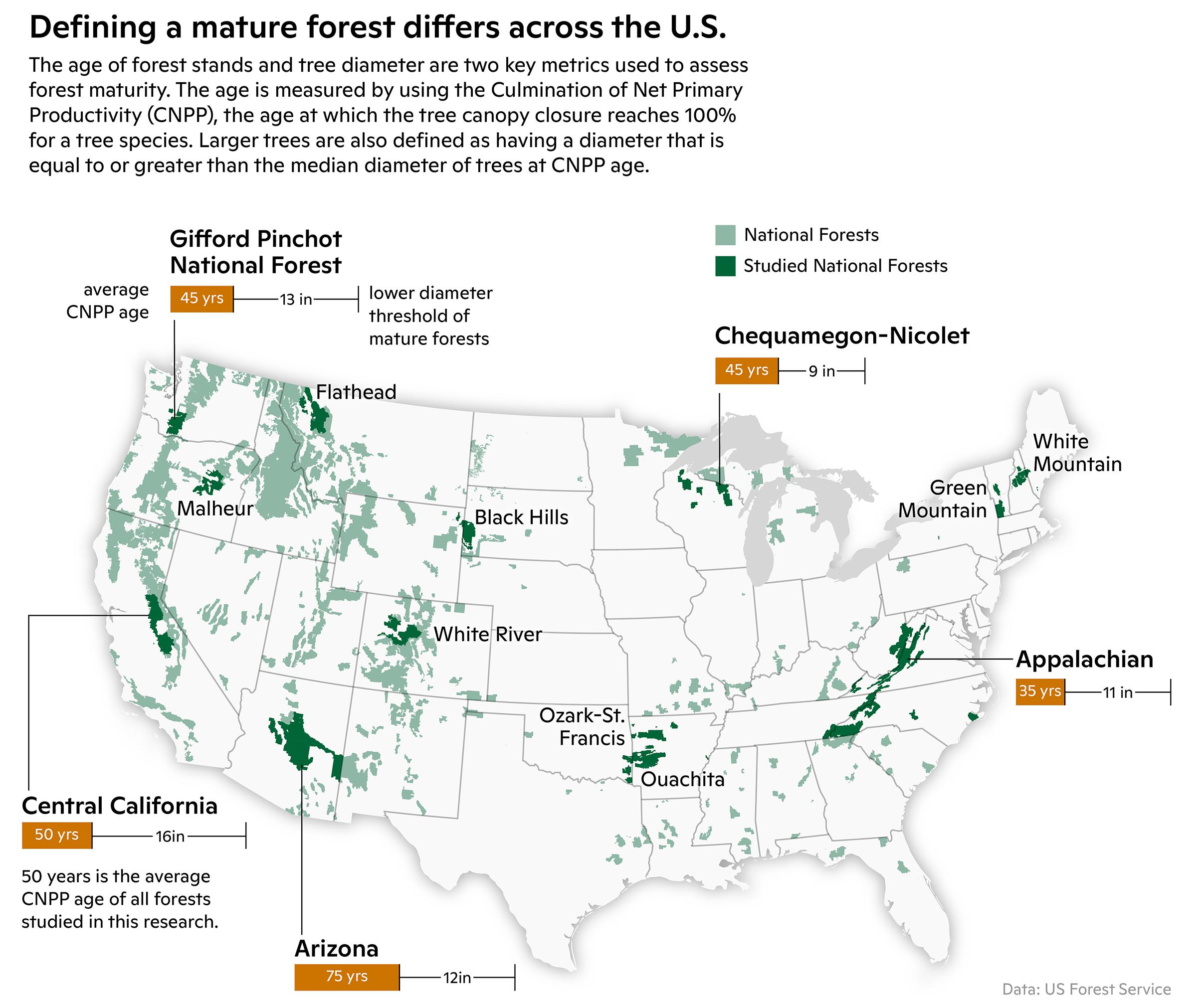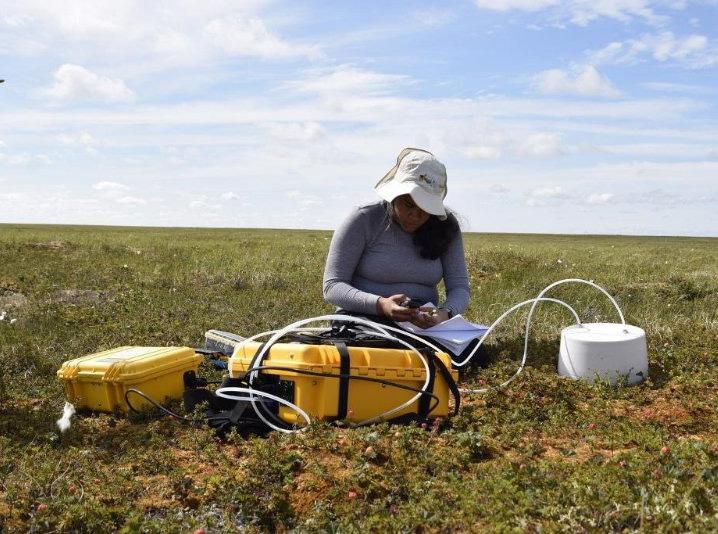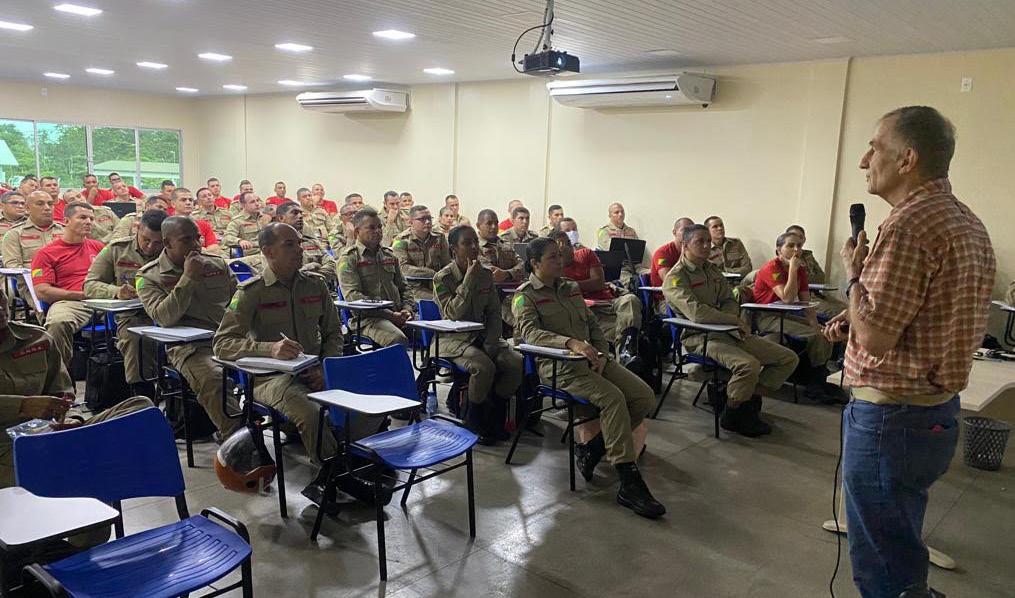

How old is mature? New definitions could inform federal forest policy
A new study, published in the peer-reviewed journal Forests and Global Change, presents the nation’s first assessment of carbon stored in larger trees and mature forests on 11 national forests from the West Coast states to the Appalachian Mountains. This study is a companion to prior work to define, inventory and assess the nation’s older forests published in a special feature on “natural forests for a safe climate” in the same journal. Both studies are in response to President Biden’s Executive Order to inventory mature and old-growth forests for conservation purposes and the global concern about the unprecedented decline of older trees.
Scientists have long demonstrated the importance of larger trees and older forests, but when a tree is considered large or a forest mature has not been clearly defined and is relative to many factors. This study develops an approach to resolve this issue by connecting forest stand age and tree size using information in existing databases. This paper also defines maturity by reference to age of peak carbon capture for forest types in different ecosystems. But the approach is readily applicable across forest types and can be used with other definitions of stand maturity.
Key findings include:
■ The minimum age at which forests may be considered mature, according to peak carbon capture, ranged from 35 to 75 years among the regions and forest types studied.
■ The carbon stored in all trees of the 11 forests totaled 561 million metric tons, of which 73% is in larger trees and 60% is in unprotected larger trees in mature stands.
■ For 8 of the 11 forests that had carbon accumulation data, the annual rate was 4.7 million metric tons per year, of which about half is in unprotected larger trees in mature stands.
Forest stands with the greatest carbon stored and highest annual carbon accumulation were mainly in the Pacific Northwest, and
all but one of the national forests (Black Hills in South Dakota due to drought and insect related tree mortality) experienced an increase in above-ground carbon over recent years.
Researchers used thousands of forest plots obtained from the U.S. Forest Service “Forest Inventory and Analysis” (FIA) dataset to determine the amount of carbon absorbed from the atmosphere that accumulates and is stored in individual trees as they mature. As trees age, they absorb and store more carbon than smaller trees, making them uniquely important as nature-based climate solutions. Additionally, as the entire forest matures, it collectively accumulates massive amounts of carbon over centuries in vegetation and soils. The study identified the forest age at which carbon accumulation is greatest, and used that as the threshold for defining a “mature” forest. Scientists also determined the median diameter of trees at this threshold age and how much of the forest carbon of the larger trees in mature forests is unprotected from logging. The amount of carbon in unprotected larger trees in mature stands of the 11 forests studied, representing only 6% of federal forest land, is equivalent to one-quarter of annual emissions of carbon dioxide from fossil fuels in the U.S. This is consistent with prior work.
According to lead researcher, Dr. Richard Birdsey of Woodwell Climate Research Center, “our study determined when an individual tree in a forest can be considered mature and when the forest itself is at an optimal rate of carbon capture and storage for conservation purposes. It is directly responsive to the president’s executive order.”
The Biden administration has set bold emissions reduction targets of 50-52% of 2005 levels and recently announced a “roadmap for nature-based solutions” as part of this effort. However, the roadmap neglects to connect the importance of protecting older forests to the climate targets. Federal agencies are proceeding with an inventory of mature and old-growth forests in response to the executive order, but policies regarding
Not all forests are equal in carbon sequestered, mature forests are pulling more weight
Dominick DellaSala Wild Heritage, Chief Scientist
Richard A. Birdsey Woodwell Climate, Senior Scientist
their management have not yet been established. By protecting older forests and trees on federal lands from avoidable logging, the Biden administration can help close the gap on its emissions reduction goals. The methodology in this paper provides a readily implementable path for critical policy solutions.

According to Dr. Dominick DellaSala, Chief Scientist at Wild Heritage, “there seems to be a big disconnect between what the White House is wanting and how federal agencies are responding to the president’s forest and climate directives. While the Forest Service recently withdrew a controversial timber sale in older forests on the Willamette National Forest in Oregon (“Flat Country Project”) because it was inconsistent with the president’s directives, dozens of timber sales in older forests remain on the chopping block.”
Dr. Carolyn Ramírez, Staff Scientist with the Forests Project at the Natural Resources Defense Council, pointed to the findings as supporting the push by over 100 conservation groups–the Climate Forests Campaign–for a national rulemaking to protect mature forests and big trees from logging for their superior climate and biodiversity benefits: “This work reinforces how essential mature forests on federal lands are to securing our climate future. It’s now up to the agencies to protect these carbon storing champions from the chainsaw with formal safeguards. Our approach shows that logging protections grounded in a straightforward, age-based cutoff—such as 80 years, as many are calling for—would protect significant amounts of carbon, accommodate forest growth differences, and be readily usable in the field.”
Cumulative impacts of Brazil’s hydroelectric plants
Damming the Cerrado places a threatened ecosystem at risk of further destruction
Sarah Ruiz Science WriterRecent research has quantified the cumulative impact of dams on Brazil’s native savanna ecosystem, the Cerrado. The study created an index of the direct and indirect impacts of constructing hydroelectric facilities on both the rivers being dammed and the surrounding ecosystem.
While often offered as a cleaner alternative to fossil fuels, dams can have severe environmental impacts ranging from deforestation to obstruction of fish migrations, water pollution, and even direct greenhouse gas emissions resulting from inundation of the surrounding area. This study assessed these effects cumulatively, weighting them more heavily if multiple dams were present in a single watershed.
“For freshwater systems, there’s not the equivalent of a deforestation rate. We don’t have an easy metric of ecosystem damage. So this study was one way of building a method for assessing the unintended consequences of installing a dam in a Cerrado watershed,” says Woodwell Climate Water program director
The study puts forward a new Dam Saturation Index (DSI) for the region to approximate the environmental impacts of existing dams. High-saturation watersheds were concentrated in the central and western portions of the biome, and most planned dams are located in sensitive areas of native vegetation with little protection.
Understanding hydropower in Brazil
Hydropower is big in Brazil—66% of the country gets some or all of their energy from it. Harnessing the power of a river is often the easiest means of electricity production in rural and remote areas. However, large hydroelectric plants are more often used as a means of infrastructural support for extractive industries like mining, rather than to expand access to electricity for rural citizens. Conflicts have already arisen between communities and hydroelectric plants.
Conflict over water usage in the Cerrado is expected to increase as the region continues to get hotter and dryer due to human-caused climate change. Land use change in the biome has accelerated the impacts of climate change, removing the cooling and moisture-retaining effects of natural vegetation.
“There are a lot of dams already, and many more planned, and it’s only going to get more contentious as climate change continues,” Dr. Macedo says. “In the northern and eastern part of the Cerrado, it’s already quite dry. We’re already seeing conflict over water and these reservoirs could just make that worse as upstream locations are able to withhold water from those downstream.”

What this means for the Cerrado
The Cerrado has historically not garnered as much attention, or as many demands for its protection, as the neighboring Amazon rainforest. Less than 10% of the Cerrado is considered protected, and many of those protections are biased toward terrestrial habitats and species.
above: Reservoir created by the Furnas Dam in Minas Gerais. / photo by Oton Barros, Flickr Dr. Marcia Macedo, who collaborated on the paper.Lack of research into the full impact of hydropower on the watersheds of the Cerrado has left the region vulnerable to unchecked development. Some dams have even been built in areas otherwise strictly protected. Dr. Macedo hopes this study will encourage a different attitude towards freshwater resources.

“There is a question of how we can innovate thinking about protecting freshwater systems, especially under climate change. They’re so important, and there are so many resources—fisheries and clean water and more—that come from these systems,” Dr. Macedo says.
This study focused on large hydroelectric dams, but Dr. Macedo notes that there are many more small dams, built to serve individual farms, that also impact the flow of headwater streams. Ongoing research is focused on understanding the cumulative impacts of dams of all sizes on tropical watersheds.

2023 John Schade Memorial awardees announced New recipients demonstrate scholarship values, including mentorship and representation
Sarah Ruiz Science WriterPolaris Project alumni and early career scientists, Aquanette Sanders and Edauri Navarro-Peréz were awarded the 2022 John Schade Memorial scholarship. The fund, established to honor Dr. Schade’s unwavering dedication to mentoring young scientists, recognizes two students per year who are pursuing higher education and reflect Dr. Schade’s values of mentoring, education, leadership, equity in the sciences, and advancing Arctic and environmental science to mitigate climate change.
“The purpose of the fund is to support the next generation of scientists who are making a lifelong career and personal
commitment to activities that reflect and demonstrate Dr. Schade’s values,” said Dr. Nigel Golden, a postdoctoral researcher at Woodwell and coordinator of the fund. “We were profoundly impressed with this round of applications. All of the applicants for the scholarship were exceptional early-career scientists who are doing timely and important research, and whose career trajectories have been impacted by their mentorship through Dr. Schade, or through their mentors who worked with him. For Aqua and Edauri, what really helped to set them apart was a demonstrable commitment to creating spaces to ensure the success of scientists from a diversity of backgrounds.”
Aquanette Sanders
Aquanette Sanders is a Masters student at the University of Texas, Austin, pursuing a degree in Marine Science. However, as a Polaris participant, Sanders’ research focused on the soil. She studied greenhouse gas fluxes from thermokarst features—depressions and bumps in the tundra landscape formed by permafrost thaw. Sanders studied how emissions of carbon dioxide, methane, and nitrous oxide differed between these features and undisturbed areas of tundra.
Sanders’ career so far has taken her from an undergraduate research program with Maryland Sea Grant, to a SEA Education cruise to the Sargasso sea, to the Simpson Lagoon on Alaska’s North Slope, where she is currently researching groundwater nutrient flows as they change with thawing permafrost. For Sanders, the experience with Polaris affirmed her interest in climate change and Arctic science.
“The Polaris Project was my gateway into Arctic science,” says Sanders. “Seeing the effects of permafrost thaw first-hand, with the large amount of thermokarst features in the Yukon-Kuskokwim Delta, confirmed that my research interest in greenhouse gasses and nutrient cycles—a topic that still has so many rising questions that need to be answered.”
Sanders says she is always looking for her
next step forward in research. She plans to pursue a dual doctorate in veterinary medicine and research after completing her masters degree. She wants to combine her background in chemistry and biology to understand how changes in nutrients will affect aquatic animals at the top of the food web.


“My research is motivated purely by the eagerness to learn more. As I find new results, I ask more questions that eventually lead to more experiments or hypotheses. This keeps me excited and ready for present and future research,” says Sanders.
Edauri Navarro-Pérez
Edauri Navarro-Pérez is a Ph.D. candidate at Arizona State University, with a background in soil, root ecology, and drylands restoration. As a Polaris student, Navarro-Pérez investigated whether there were differences between emissions coming from burned and unburned areas of the tundra. Her work contributed to a body of research examining how fires are affecting chemical processes in tundra soils—specifically respiration, which emits carbon and nitrogen. For her, Polaris was an opportunity to gain experience with field methods.
“Polaris contributed a lot to my knowledge in terms of how soil science is done in the field, as well as the process of the scientific method—from developing
my own question to seeing the results of my work,” Navarro-Pérez said. From Polaris, to working as an undergraduate lab technician, to conducting research in Belize and Costa Rica, Navarro-Pérez is led by her curiosity. She is especially interested in the way soil connects to our daily lives, and how understanding the interactions between plant roots and the soil in which they’re growing can lead to a deeper understanding of climate change.
“Understanding how restoration projects can affect plant development and how plants can affect soils in the longer run, through decomposition and soil respiration, can be pertinent to environmental planning for climatic issues,” said Navarro-Pérez.
Navarro-Pérez said she feels grateful that an environmental scholarship supporting Latina and Latino students enabled her to earn her undergraduate degree. She now hopes that her future career will involve research, mentoring, and teaching, as well as exploring her research topics through art and literature which provides a different frame for examining the world around us.
Both recipients will receive funding to continue their education and pursuit of science, mentorship, and equity, encouraging a new generation of Arctic scientists working to change the world.
Dr. Foster Brown, Senior Scientist Emeritus, gave a talk titled “Disasters and Climate Change: The Role of the Fire Department and Civil Defense of Acre” to more than 60 bombeiros/firefighters in Acre, Brazil who had entered the state firefighters program for officers.

In the news: highlights
Yale Daily News mentioned Dr. Nigel Golden in an article covering his recent publication on fear and bias in ecological research.
Dr. Christina Schaedel was interviewed by MBN-USAGM network/AlHurra on climate change in Alaska (Arabic).
Dr. Wayne Walker was mentioned in an El Dia article on his research about unrealized potential carbon storage on land (Spanish).
IPAM published an article to their website mentioning the CONSERV program as an example of critical work to reduce deforestation (Portuguese).
Living on Earth radio program and podcast featured Dr. Jen Francis as a guest to talk about extreme weather and the jet stream.
La Patilla quoted Dr. Wayne Walker in an article covering a recent study where he and co-authors developed a dataset that helps map terrestrial carbon sinks (Spanish).
Dr. Richard Birdsey was interviewed on Jefferson Public Radio’s The Jefferson Exchange about a newly published paper establishing definitions for mature trees and forests on federal lands. The same paper was also covered in an article from Greenwire.
Drs. Max Holmes and Jen Francis were both quoted in an article from The Boston Globe, offering their thoughts on what to expect when we emerge from La Niña.
An article from The New York Times described research by Dr. Paulo Brando in an article about the Amazon tipping point.
Journalists once again turned to Dr. Jen Francis for context on weather whiplash this week: she was quoted in articles from Vox, Financial Times, The Boston Globe, The Straits Times, and an Associated Press article syndicated to many outlets including TIME and NPR.
News Channel Nebraska Central highlighted Dr. Sue Natali, as well as Board member Tod Hynes as presenters at the Davos Green Accelerator.
Dr. Jen Francis was quoted extensively on climate change and extreme cold these past two weeks—over 325 times. She was quoted or mentioned in The New York Times, AP News, CNET, The Washington Post, Financial Times, The Straits Times, Bloomberg, and even Breitbart
TIME quoted Dr. Ludmila Rattis for context on the effort to transition Brazilian monoculture agriculture to agroforestry, which was picked up by Yahoo!News, The Press United (India), and others.
A Medium article by Kontur Inc. highlighted a map by Greg Fiske as the first in a roundup of #30daymapchallenge maps made with their population dataset.
Eos quoted Dr. Anna Talucci on fire refugia in Siberia in an article about how climate change is affecting these important areas.
Health in Harmony mentioned their collaboration with Woodwell in a Q&A article from Mongabay.
Wellington’s partnership with Woodwell is mentioned in an op-ed on biodiversity, climate change, and capital markets on Trustnet.
Please help us to conserve paper. To receive this newsletter electronically, please send your email address to info@woodwellclimate.org.
woodwellclimate.org/give
@woodwellclimate #sciencefortheworld

Donations play an important role in securing the future of Woodwell Climate Research Center’s work—and help safeguard the health of our planet for generations to come.
